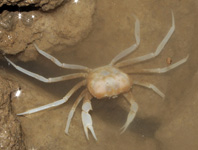Abstract
The family Sphaerolaimidae Filipjev, 1918 includes nematodes that are characterized by the finely striated cuticle, round amphids, broad buccal cavity with longitudinal ribs, and single anterior ovary in females. Parasphaerolaimus species from this family are found in intertidal and subtidal sediments and have also been reported from mangroves and estuaries. Parasphaerolaimus pilosus sp. n. is characterized by the moderately plump body, presence of lateral alae, long cervical setae, small amphids in males, and relatively short spicules. As a result of a comprehensive evaluation of species descriptions, eight species in the genus Parasphaerolaimus are recognized valid, and an identification key to species level is provided.
References
Boucher, G. (1972) Redescription de neuf espèces de Nématodes libres marins de la baie de Banyuls-sur-mer. Bulletin du Musee Royal d’Historie Naturelle de Belgique, 40, 450‒473.
Cobb, N.A. (1898) Australian free-living nematodes. Proceedings of the Linnean Society of New South Wales, 23, 383–407.
Cobb, N.A. (1932) The English world “nema”. Journal of the American Medical Association, 98, 75.
De Grisse, A.T. (1969) Redescription ou modifications de quelques techniques utilisées dans l’étude des nématodes phytoparasitaires. Mededelingen van de Rijksfakulteit Landbouwwetenschappen Gent, 34, 352–369.
Ditlevsen, H. (1919) Marine free-living nematodes from Danish waters. Videnskabelige Meddelelser fra Dansk naturhistork Forening i Kobenhaven, 70, 147–214.
Ditlevsen, H. (1926) Free-living nematodes. The Danish Ingolf Expedition, Volume IV, 6, 1–42.
Eisenback, J.D. (1986) A comparison of techniques useful for preparing nematodes for scanning electron microscopy. Journal of Nematology, 18, 479–487.
Filipjev, I.N. (1918) Free living marine nematode of the Sevastopol area. Transactions of the Zoological Laboratory and the Sevastopol Biological Station of the Russian Academy of Sciences. Series II, N4, I, II.
Filipjev, I.N. (1929) Classification of freeliving Nematoda and relations to parasitic forms. Journal of Parasitology, 15, 281–282.
Filipjev, I.N. (1946) Nématodes libres du bassin polaire. Trudy Dreifuiushchaiae Ekspeditsiia Glavsevmorputi ne Ledokol’nom Parkhode “G. Sedov” 1937-1940, 3, 158–184.
Fonseca, G. & Bezerra, T.N. (2014) Order Monhysterida Filipjev, 1929. In Schmidt-Rhaesa, A. (Ed.). Handbook of Zoology. De Gruyter, Hamburg, pp. 435–465.
Gagarin, V.G. (2014) Two new species of free-living nematodes (Nematoda, Sphaerolaimidae) from mangroves of the Red River Delta, Vietnam. Amurian zoological journal, 4, 3–11.
Gerlach, S.A. (1956) Brasilianische Meeresematoden I. Boletim do Instituto Oceanográfico daUniversidade de São Paulo, 5, 3–69.
https://doi.org/10.1590/S0373-55241954000100001Gourbault, N. & Boucher, G. (1981) Nématodes abyssaux (Campagne Walda du N/O “Jean Charcot”) III. Une sous-familie et six espèces nouvelles de Sphaerolaimidae. Bulletin du Meseum national d’Histoire naturelle de Paris, 4, 1035–1052.
Inglis, W.G. (1983) An outline classification of the phylum Nematoda. Australian Journal of Zoology, 31, 243–255.
https://doi.org/10.1071/ZO9830243Jensen, P. (1992) Predatory nematodes from the deep-sea: description of species from the Norwegian Sea, diversity of feeding types and geographical distribution. Cahiers de Biologie Marine, 33, 1–23.
Lorenzen, S. (1978) The system of Monhysteroidea (Nematoda) – A new approach. Zoologische Jahrbücher (Abteilung für Systematik, Ökologie und Geographie der Fiere), 105, 515–536.
Seinhorst, J.W. (1959) A rapid method for the transfer of nematodes from fixative to anhydrous glycerin. Nematologica, 4, 97–69.
https://doi.org/10.1163/187529259X00381
Timm, R.W. (1961) The marine nematodes of the Bay of Bengal. Proceedings of the Pakistan Academy of Sciences, 1, 25–88.
Warwick, R.M., Platt, H.M. & Somerfield, P.J. (1998) Free-living marine nematodes. Part III Monhysterids. In: Synopses of the British fauna. New Series. Field studies Council, Shrewsbury, pp. 53.
Wieser, W. (1956) Free-living marine nematodes III. Axonolaimoidea and Monhysteroidea. Reports of the Lund University Chile Expedition 1948-49. Lunds Univenztets Arsskrift, 52, 1–115.

